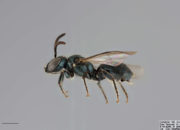Small Carpenter Bees are among the most frequently encountered bees in Vermont, and the easiest bees to find through the winter (if you know where to look). All four species known from the northeastern US have been found in VT, but the vast majority of photos of live bees are not identifiable to species.

Female Small Carpenter Bee inside a hollow stem, where they overwinter as adults © Spencer Hardy
Small Carpenter Bees of Vermont
Genus level ID
This is a good group to recognize since they are so common but very hard to identify to the species level from photos. Look for small, slightly metallic bees with distinctly swollen rear ends. Their large heads, often with an ivory color mark, is another good field mark. Males and females can be separated by the shape of the white mark on the face – vertical or lacking in females, horizontal in males.
Unless otherwise specified, photos are courtesy of Margarita Miklasevskaja at PCYU with funding from NSERC-CANPOLIN.
Species Accounts
Male Spurred and Nimble Ceratina have a distinctive triangular hind femur that is occasionally visible in photos. The other two species are impossible to ID without a microscope.
Spurred Ceratina (Ceratina calcarata) – Common and widespread. Males can be identified by the shape of the hind femur.
Doubled Carpenter Bee (Ceratina dupla) – Widespread but somewhat localized. Very similar to the Mikmaq Little Carpenter.
Mikmaq Little Carpenter Bee (Ceratina mikmaqi) – Described in 2011, this species is very similar to the Doubled Carpenter. Records from specimens suggest its is the more common of the two species.
Nimble Carpenter Bee (Ceratina strenua) – A small, southern species known from a few recent specimens in western VT. The only species where females have white marks on the front tibia, which is also distinctive among males when combined with the triangular femur.
Please note that many of our datasets have not been published yet, so the maps are incomplete.













